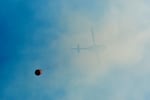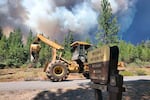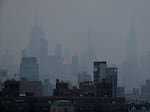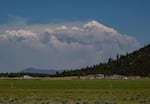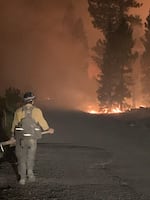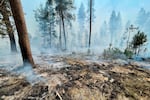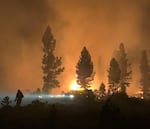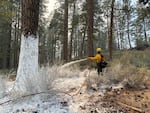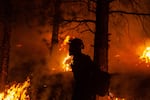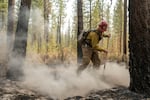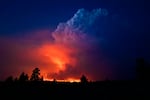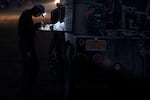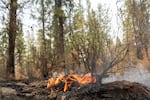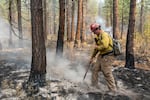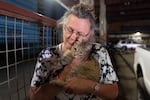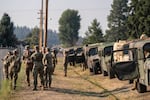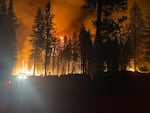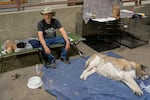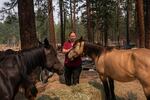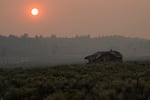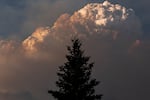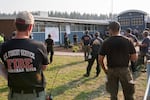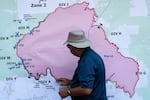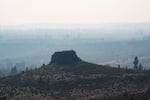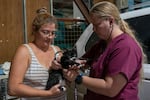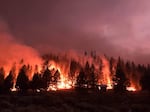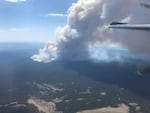
Smoke from the Bootleg Fire as it burns near the Nature Conservancy's Sycan Marsh Preserve.
Katie Sauerbrey/The Nature Conservancy (With Permission)
Since it started on July 6, 2021, the Bootleg Fire has been characterized by its size and speed. Miles of forest land has burned each day. At over 400,000 acres, it’s Oregon’s third largest wildfire since 1900. In recent weeks firefighters have had to retreat multiple times as embers crossed containment lines and hot, dry and windy weather made fighting the fire impossible.
The footprint of the Bootleg Fire includes a history of commercial logging, thinning, clear cutting, prescribed fire and other intensive management practices, according to Bryant Baker, conservation director of Santa Barbara, California, nonprofit Los Padres ForestWatch. Baker says those management activities contributed to the fire’s spread. One example, he says, is when it burned into the U.S. Forest Service’s Black Hills Ecosystem Restoration Project.
“Essentially the fire burned through these areas really quickly,” Bryant says. “So, the fire in its initial rapid growth burned right through these pretty expansive areas of commercial thinning and prescribed fire and did not seem to slow down.”
Baker, a cartographer, does real-time GIS analysis of how landscapes were historically managed while wildfires are actively burning on the land. With the Bootleg Fire, he used satellite and aerial images, and maps made from U.S. Forest Service and Oregon Department of Forestry data, that show past logging, thinning and prescribed burn projects.

A map depicting forest management history in the Bootleg Fire burn zone. GIS analyst Bryant Baker created the map with state and federal land management data as the wildfire burned.
With Permission, Bryant Baker/Los Padres ForestWatch / Los Padres ForestWatch
“I do think this demonstrates that this kind of focus on removing vegetation from these wildlands, especially far away from human communities, is not doing anything to prevent these fires from becoming very large,” he says.
Past commercial logging and livestock grazing has encouraged wildfires, according to Timothy Ingalsbee, executive director of Firefighters United for Safety, Ethics and Ecology. Ingalsbee, who is an advocate of prescribed burning, notes that when the fire entered the Gearhart Mountain Wilderness, an area with more potential fuel but fewer small trees and flammable grasses, it appears to have burned more slowly.
According to Baker’s analysis, the fire slowed from moving 3.4 miles per day on managed land to 2.1 miles per day in the Gearhart Wilderness.
“It’s not a huge difference, but it is a difference,” Baker says.
The rapid spread of the Bootleg Fire also poses a risk to firefighters.
“These fires are just hop-scotching across the landscape, leap-frogging across fire lines and all other traditional places you might try to contain a fire,” Ingalsbee says.
But, in an illustration of the debate over how to best treat forests for fire, other officials have altogether different interpretations of the impact of forest management on the Bootleg Fire.
Representatives from the U.S. Forest Service argue that their prescribed fire and tree-thinning work successfully reduced the intensity of the Bootleg Fire. An agency statement focused on the same Black Hills Ecosystem Restoration Project described a “low-intensity underburn, which will add nutrients to the soil.” Photos of nearby untreated lands show blackened trees, denuded of branches.
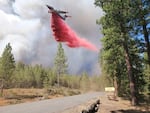
In this photo provided by the Bootleg Fire Incident Command, a plane drops retardant near Mitchell Monument in the Bootleg Fire, July 19, 2021.
Bootleg Fire Incident Command via InciWeb
“Years of hard work has paid off,” the release reads.
The Bootleg Fire is currently burning around the Sycan Marsh Preserve, 30,000 acres of marsh and wetlands owned and managed by The Nature Conservancy on the western edge of Lake County. As of Wednesday, more than 12,000 acres had burned on three sides of the preserve.
The Nature Conservancy’s Oregon Forest Program Director Pete Caligiuri has helped manage this landscape with tree thinning projects and prescribed fire to replicate a more natural forest condition. Anecdotal accounts from firefighters suggest those efforts reduced the Bootleg Fire’s intensity, he says.
“As fire moved into these areas where he had done that work of first thinning out small trees and then reintroducing prescribed fire, the fire went from more of a crown fire, to more of a surface fire with low-to-moderate intensity,” Caligiuri says.
He says it’s too early to know conclusively how their forest management practices influenced the Bootleg Fire’s growth. The Nature Conservancy plans to refine and adapt their restoration efforts after the fire is contained, he says.
“We’re primed for this very important experiment and to test our work to see how it did fare on the preserve where we had controls or no treatment areas, as well as off the preserve,” Caligiuri says.
Overall, Bryant Baker says, the Bootleg Fire is being driven by windy, hot weather and drought conditions that have been magnified by climate change. And prioritizing fuel reductions like thinning, logging and prescribed burns are “ineffective and counterproductive.”
He says communities in the West should instead learn to live with wildfire by using limited funding for home hardening, creating defensible space, and emergency alert and evacuation systems.
“We’ve really got to shift our focus away from trying to manage the landscape,” Baker says, “to instead trying to manage our own communities so they’re prepared for these inevitable wildfires.”

